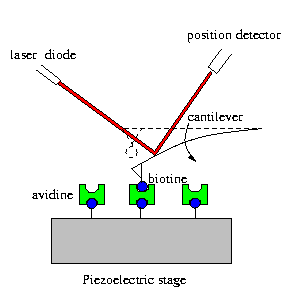afm
Atomic Force Microscopy
Atomic Force Microscopy (AFM) appears as a very natural tool to work
in the single molecule domain. This apparatus was originally designed
to visualize surfaces with atomic scale resolution. Its working
principle is to scan the surface of a sample with a very sensitive
position detector and to record the modulation of the topological
signal. The AFM relies on a very thin cantilever as a detector.
Somewhat similar to the needle of a DJ�s record player, this
micro-fabricated beam is typically 100 microns long, 10 microns wide
and a fraction of a micron thick. It has an extremely sharp tip at its
end (radius of curvature in the tens of nanometers). The position of
this cantilever is measured by reflecting a collimated laser beam onto
its surface and imaging the light spot on a two- or four- quadrant
diode detector. The sample is scanned horizontally by a XY piezo
stage, providing atomic resolution.
As we have stated, the AFM is primarly a visualization tool and its
use as a single molecule micromanipulation device is a secondary
feature. The very sensitive cantilever has motivated researchers to
use this device to measure the force required to stretch a biopolymer
or to break a molecular bond. To achive this goal, the operator stops
the horizontal sample-scanning process and gently moves the cantilever
vertically above the sample while recording its deflection. The AFM
provides some natural features :
-
The position of the cantilever can be adjusted with sub-nanometer
resolution and the vertical scanning speed can be high.
-
The deflection of the cantilever is also read with sub-nanometer
resolution, and the response time is in the milli-seconde range.
-
The AFM may be used to visualize the sample.
-
Strong forces in the nanoNewton range may be applied to the sample.
The force sensitivity of the AFM is related to the cantilever�s size
and stiffness. Different cantilevers provide a range of stiffness from
1 N/m to 10-3 N/m (or 1pN to 1 nN per nanometer) of cantilever
deflection. A very common error consists in saying that the best
sensor is the one with the smallest stiffness. We shall see that the
best sensor (in term of signal to noise) in in fact the smallest
device. Since the cantilever size is typically 100 microns they are
not the best sensors in terms of noise. A strong effort is under way
to reduce the size of the cantilever to improve their signal to
noise. Typically the minimum force measured with the AFM is 5 pN.
| |
Bibliography |
| 1 | ADHESION FORCES BETWEEN INDIVIDUAL LIGAND-RECEPTOR PAIRS
EL. Florin, VT. Moy, HE. Gaub,
Science
(1994) 264-5157 p.415 Science publications
CrosRef
|
| 2 | Small cantilevers for force spectroscopy of single molecules
MB. Viani, TE. Schaffer, A. Chand, M. Rief, HE. Gaub, PK. Hansma,
J. Appl. Phys.
(1999) 86-4 p.2258 PubMed CrosRef
|
For further information please contact 

